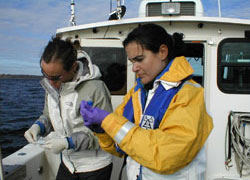 |

For further information, contact the MBL Communications Office at (508) 289-7423 or e-mail us at comm@mbl.edu
For Immediate Release: May 3, 2007
Contact: Gina Hebert, MBL, 508-289-7725; ghebert@mbl.edu
Back to Resource Page
 |
|
MBL Assistant Research Scientist Linda Amaral Zettler (right) and Research Assistant Jennifer Rocca (left) collect samples in Mount Hope Bay, MA
Photo credit: Erik R. Zettler
|
|
Study Finds High Levels of Fecal Microbes in New Orleans Sediments Following Hurricanes Katrina and Rita
MBL, WOODS HOLE, MA—In a new study documenting the microbial landscape of New Orleans and Lake Pontchartrain in the wake of Hurricanes Katrina and Rita, scientists report that sediments in interior portions of the city appear to be contaminated with fecal microbes, a chronic condition they say persisted in the area before the hurricanes, and that the resulting water quality in the city and in nearshore waters of the lake continues to be impacted by discharges from this contamination.
According to the study authors, including Marine Biological Laboratory (MBL) Assistant Research Scientist, Dr. Linda Amaral Zettler, while floodwaters pumped from New Orleans back into Lake Ponchartrain following the Hurricanes showed higher-than-normal levels of bacteria and pathogens, fecal indicator microbe and pathogen concentrations in the lake returned to pre-hurricane levels within two months. However, the sediments left behind in the flooded regions of the city appear to contain microbes commonly found in sewage treatment and remain a cause for concern because they may serve as a potential source of ongoing microbial exposure.
The report, which appears this week’s Online Early Edition of The Proceedings of the National Academy of Sciences, maintains that further investigation is needed to evaluate the microbial quality of floodwater sediments deposited in the New Orleans area and highly recommends epidemiologic studies to determine whether there is an elevated risk of exposure to human pathogens through contact, ingestion, and inhalation of these sediments.
The study was a collaborative response of several institutions, including the Woods Hole Center for Oceans and Human Health, of which the MBL and Amaral Zettler are a part. The researchers began collecting water and sediment samples from the interior canals and shoreline of New Orleans and the offshore waters of Lake Pontchartrain in October 2005 after the floodwaters had receded. They examined the presence of a diverse group of microbes including fecal indicators E.coli and others, as well as human pathogenic bacteria Vibrio and Legionella.
Amaral Zettler and her colleagues at the MBL led the effort to analyze overall microbial diversity in the post-hurricane water and sediment samples using DNA sequencing technology. Through analyzing the DNA makeup of the microbes found, they were able to get a big picture view of the kinds of microbes in the environment and whether or not they were similar in makeup to known pathogens or to microbes typically found in sewage treatment.
Amaral Zettler points out the importance of knowing the microbial landscape of an area before a natural disaster hits. Some pathogens are endemic to the natural environment and some are introduced through sewage and run-off. Likewise, microbial communities are under the influence of seasonal variability in temperature and salinity that will naturally affect microbial population structure. “Our hope is that this data will provide some perspective not just on the immediate impact to the area, but the long term effects of this kind of natural disaster,” says Amaral Zettler. “We certainly know a lot more now about the microbial diversity present in Pontchartrain than we did when we started the study.”
According to Amaral Zettler, the Centers for Oceans and Human Health network enabled the team to mobilize quickly. “The logistics of sampling were tremendous,” she says. “Security was huge and the logistics of just getting around the city at that time were not trivial,” she says. A collaborative grant from the National Science Foundation made it possible for the scientists to leverage their expertise and use their resources to contribute to a common goal. “We really felt that as centers we were serving a role. This research would have been next to impossible if we would have had to go it alone—a true example of the whole being greater than the sum of its parts.”
This work was funded by the National Science Foundation (NSF), the National Institute of Environmental Health Sciences Ocean and Human Health Program, and the NSF Small Grant for Exploratory Research Program, the NSF Research Experiences for Undergraduates Program, and by the Georgia Sea Grant College Program.
Note to Editors: The paper entitled "Impacts of Hurricanes Katrina and Rita on the Microbial Landscape of the New Orleans Area” will be published in the online Early Edition of The Proceedings of the National Academy of Sciences sometime during the week of April 30, 2007. For full text of the paper, media contact Gina Hebert, ghebert@mbl.edu.
The MBL® is a leading international, independent, nonprofit institution dedicated to discovery and to improving the human condition through creative research and education in the biological, biomedical and environmental sciences. Founded in 1888 as the Marine Biological Laboratory, the MBL is the oldest private marine laboratory in the Western Hemisphere. For more information, visit www.MBL.edu
|